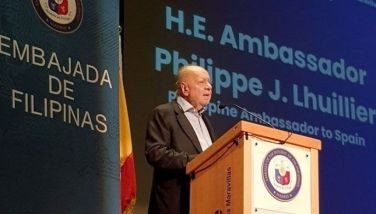The penguins are coming home to Phillip Island
MELBOURNE, Australia — In the gray dusk, wrapped up against the winds blowing in from the Bass Strait, a few dozen humans huddle on the viewing stands and watch the beach. The ranger has admonished us to be quiet, to stay seated and make no sudden movements. I am wearing three layers of clothes and still cold, but 48 hours earlier I was melting in Manila’s summer so I’m not complaining. The sound of waves rolling onto the shore is lulling me to sleep.
Remember, the ranger told us, that the walk across the beach is the scariest part of the trip, and we don’t want to do anything that might alarm the birds. Many of the visitors seated on the stands are Asian tourists, ourselves included. One of them lights a cigarette — he is either cold, desperate for nicotine, or just a jerk.
“Put out that cigarette,” says the lady sitting next to me. He does not hear her, or he pretends not to understand English, or he’s just a jerk. “Cigarette,” someone else points out. One of the rangers goes up to the smoker and tells him where he can stuff the lit butt, though not in those exact words. The smoker obliges and the ranger moves off.
“Better see where he put the cigarette, he might pick it up,” someone else suggests. The ranger goes back to ascertain that the butt is no longer smokable.
Something stirs in the brush by the stands. It’s a solitary penguin looking out to sea. What’s it doing there? Is it lost? Did it oversleep in the morning when all the penguins went out? Is it playing hooky? The penguin does not seem overly perturbed by the presence of humans.
The birds have lived on Phillip Island for thousands of years — they used to be called Fairy Penguins, but are now known as Little Penguins. At 33 centimeters in height they are the smallest penguins in the world. Their largest cousins are the Emperor Penguins, which stand at 70 centimeters. We’d seen the Emperors the previous day at the Melbourne Aquarium — handsome birds in black tuxedoes with yellow waistcoats and orange scarves, and they knew it. When aquarium visitors cluster round their glass enclosure, the Emperors pose like Brazilian-Japanese male models.
The Little Penguins with their dark blue coats and white bellies are less ready for their close-ups. According to the fact sheet, penguins’ eyes are specialized for underwater vision and for low light, making them sensitive to sudden bright light, including camera flash. If someone had produced a camera and attempted flash photography on Phillip Island I would’ve wrested the camera from him and beaten him with it. Not just because I love penguins, but because I wished I could’ve taken pictures myself.
(You can have yourself photographed with the Little Penguins, sort of: there’s a booth in the Visitors’ Center where they will Photoshop you into a penguin group shot. Among the framed pictures of penguin fans is one of the Argentinian tennis player David Nalbandian.)
At six minutes past six a single shape emerges from the water and stands on the beach. The first penguin has arrived! A ripple of excitement goes through the stands, and someone in the front row stands up for a better look. “Sit down, idiot!” says our redoubtable guide Geoff Reynolds of Tourism Victoria, our hosts on this trip. We have taken to calling him Fearless Leader Kim Jong-Geoff. He was a competitive cricket player in the under-19 age group, the head of the Japanese corporation NEC in Australia, and a government telecoms executive. Last year he retired and bought himself a Lexus convertible. The previous day Geoff had driven us to the aquarium in his snazzy convertible. For three minutes we were the coolest tourists in Melbourne.
Ten minutes later, the dim light of a few lampposts, little shapes converge on the sand, and then the shadows resolve themselves into penguins. Lots of penguins. There must be 10 dozen of them, maybe more. “I’ve been coming to Phillip Island for 10 years, but I’ve never seen this many penguins at once,” Geoff marvels.
The Little Penguins pause at the edge of the beach, alert for predators such as dogs, cats, and especially foxes. After a few moments they decide the path is clear, even with all the human kibitzers, and they start marching ashore towards their nests. The lone penguin in the bushes hurries off, probably to join them.
In the silence you hear soft, squelching noises as their flippers hit the sand. The sight of more than a hundred Little Penguins waddling to the stands is both comical and awe-inspiring. Without thinking you start imitating their headlong walk; at the same time you’re rooting for them to get home safely. You know the dangers they face every day, not just from predators but from humans. Plastic garbage that chokes or traps them, oil spills, motor vehicles, to say nothing of the effects of global warming on their habitat and food supply.
If penguins were like people they might’ve given up their natural habits long ago and opted for a safer way to live. But instinct tells them to swim out and dive for fish, sometimes for weeks on end, sleeping on the surface of the water. On their daily fishing expeditions they swim up to 50 kilometers. And instinct calls them home to Phillip Island, where the tourists tread softly alongside them on the boardwalk, wishing they could escort the penguins to safety.
Some of the birds nest under the stands and the boardwalk; others make themselves comfortable in burrows by the Visitors’ Center, where you can observe them through glass portholes. It’s tempting to try to pet a penguin — some tourists have discovered that those cute beaks can inflict nasty bites. Why do you think one of Batman’s arch-enemies was called The Penguin? Then there’s the smell, like not very fresh fish. The penguins’ waterproof feathers keep their skin perfectly dry in the water.
When the Penguin Parade ends about an hour and a half later, the humans trudge to the gift shops for stuffed toy penguins they can hug in lieu of the real ones, or to the cafe for hot drinks. We head to the parking lot where we find our driver, Peter, who is despondent because his Aussie Rules Football club has just been walloped by the reviled Collingwood. We check under the van in case a stray penguin has taken refuge there, then we climb in for the two-hour trip back to Melbourne.
Now I’m thinking of adopting a Little Penguin. For AUS$75, you get an adoption certificate and fact sheet, e-mail updates on the progress of the penguin colony and projects, a personalized thank-you card with a picture of your “baby,” an entry voucher to the Phillip Island Penguin Parade and invitation to a Members’ Open Day with a behind-the-scenes tour. You even get to name your adopted penguin. I think I’ll call him Heath, after an Australian we miss.
* * *
Philippine Airlines (PAL) flies between Manila and Melbourne five times a week. For inquiries, call 855-8888, 777-5939, or visit www.philippineairlines.com



















